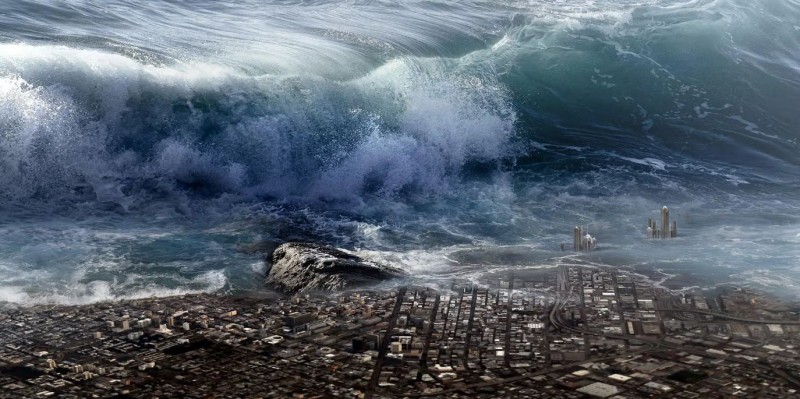
Introduction
Tsunamis, often referred to as "seismic sea waves," are one of the most devastating natural disasters known to mankind. These colossal oceanic waves can wreak havoc on coastal communities, causing immense destruction and loss of life. In this article, we will delve into the fascinating world of tsunamis, exploring their incredible speed, formation, and the catastrophic consequences they can unleash upon coastal regions.
Understanding Tsunamis: An Overview
Tsunamis are immense oceanic waves that result from the displacement of a large volume of water, usually caused by underwater earthquakes, volcanic eruptions, or landslides. Unlike regular ocean waves that are generated by wind or tides, tsunamis possess an enormous amount of energy and can travel vast distances across the open ocean.
Formation of Tsunamis: The Triggering Factors
Tsunamis are primarily triggered by underwater earthquakes, which occur when tectonic plates beneath the Earth's surface collide, separate, or slide past each other. These seismic activities can cause the ocean floor to uplift or subside rapidly, displacing massive amounts of water above it. Additionally, volcanic eruptions and landslides can also initiate the formation of tsunamis, although they are relatively less common.
Tsunamis in Motion: Speeding Across the Ocean
Once formed, tsunamis can travel at astonishing speeds in the open ocean. They can reach velocities of up to 500 mph (805 km/h), allowing them to traverse vast distances in a relatively short amount of time. However, as they approach shallow coastal waters, their speed decreases, and their height increases dramatically, leading to the destructive impact they are notorious for.
Impact of Tsunamis: Devastation Unleashed
When a tsunami makes landfall, it unleashes a wave of unimaginable force upon coastal areas. The immense volume of water carried by the tsunami inundates low-lying regions, causing widespread flooding and eroding coastlines. Structures are demolished, infrastructure is destroyed, and lives are tragically lost in the path of these powerful waves. The aftermath of a tsunami can leave affected communities in disarray, requiring extensive recovery efforts to rebuild and heal.
Tsunami Warning Systems: Saving Lives
To mitigate the devastating effects of tsunamis, various warning systems have been implemented worldwide. These systems employ a network of seismographs and ocean sensors to detect seismic activity and changes in water levels. When a potential tsunami threat is identified, timely warnings are issued to coastal regions at risk, allowing them to evacuate and seek higher ground, thereby saving countless lives.
Preparing for a Tsunami: Safety Measures
As individuals living in coastal areas, it is crucial to be prepared for a potential tsunami. Some essential safety measures include developing and practicing evacuation plans, creating emergency supply kits, and staying informed about tsunami alerts and warnings. Additionally, coastal communities must prioritize the construction of resilient infrastructure that can withstand the destructive power of tsunamis, further ensuring the safety of their residents.
The Aftermath: Recovering from a Tsunami
Recovering from the aftermath of a tsunami is a long and arduous process. It involves not only rebuilding infrastructure but also providing support and resources to affected communities. Rehabilitation efforts encompass restoring essential services, assisting in psychological recovery, and implementing measures to reduce vulnerability to future tsunamis. The collaboration between governments, NGOs, and affected individuals plays a crucial role in the successful recovery from such a catastrophic event.
Future Tsunami Research: Advancing our Understanding
Tsunami research continues to evolve, driven by the desire to enhance our understanding of these natural phenomena and improve prediction capabilities. Scientists are employing advanced technologies such as computer models, remote sensing, and real-time data analysis to gain insights into tsunami generation, propagation, and coastal impact. This ongoing research aims to provide more accurate and timely warnings, ultimately minimizing the devastation caused by tsunamis.
Conclusion
Tsunamis possess immense power and are capable of inflicting catastrophic damage upon coastal regions. With their astonishing speeds of up to 500 mph (805 km/h) in the open ocean, these massive waves represent a formidable force of nature. By implementing effective warning systems, preparing communities, and investing in research, we can work towards mitigating the devastating impacts of tsunamis and protecting the lives of those living in vulnerable coastal areas.
From Churchill to Queen Elizabeth: Stars Embracing the Legion of Honor
SC Sets Hearing Date for Sisodia's Interim Bail Plea in COVID-19 Protocol Violation Case